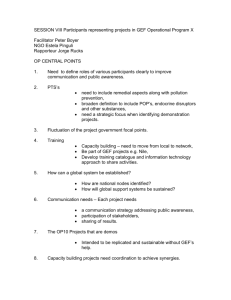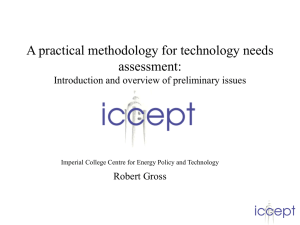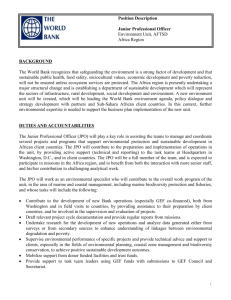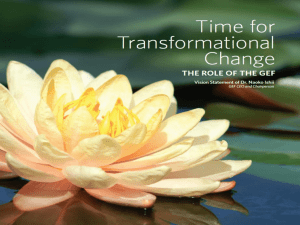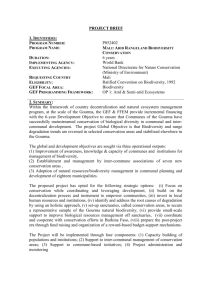Highligths of GEF investments in Africa
advertisement
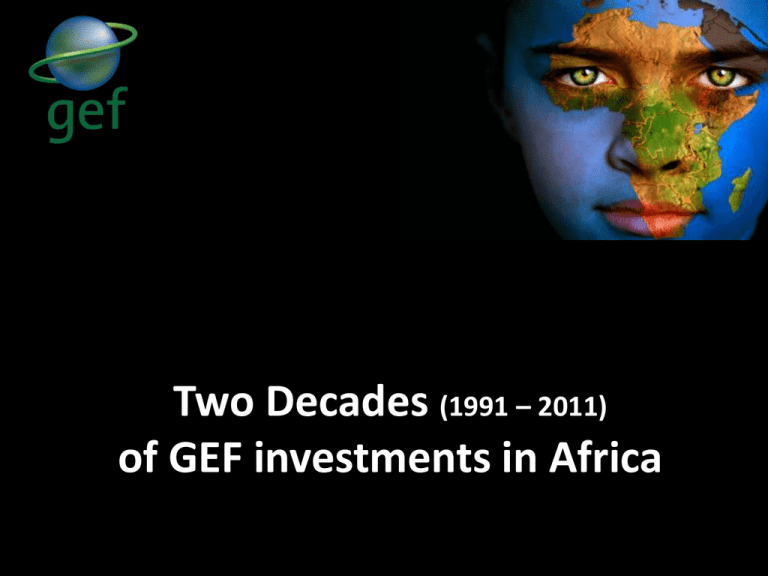
Two Decades (1991 – 2011) of GEF investments in Africa Highlights of Country Investments Note: This is overall summary of the trends on the main map! • • • • • The Biodiversity and Climate Change focal areas are the two most dominant in the majority of countries The Climate change focal area is more dominant in the North Africa region, while the Biodiversity focal area dominates Eastern and Southern Africa The Land Degradation focal area is most strongly represented in the dryland countries – mainly the Sahel and Eastern Africa Countries in the Central Africa region and the Indian Ocean have mostly focused on the Biodiversity focal area Countries with relatively small portfolios have invested in only one or two GEF focal areas, while those with larger investments have a diversified portfolio Africa’s share of the overall GEF and Focal Area Investments The GEF resources have been programmed across all focal areas, reflecting the continent’s crucial importance for ensuring a healthy and sustainable Planet. The continent utilized more than 60% of the Land Degradation focal area resources, even though the total amount is smallest of all focal areas. Since its inception, $2.6 billion or one third of all GEF resources has been invested in Africa. Trends in GEF Focal Area Investments Since inception, programming of GEF resources in Africa has increased consistently for the Biodiversity and Climate Change focal areas. The International Waters focal area showed the greatest gain from the Third Replenishment Phase (GEF-3), reflecting a shift from foundational activities during the earlier phases toward implementation of Strategic Action Plans developed by cooperating countries. Breakdown of GEF Investments between Country and Regional Initiatives Investments in Biodiversity Conservation and Climate Change account for the largest share of overall GEF programming in Africa. Investments under International Waters, Land Degradation, and Persistent Organic Pollutants are also significant. Two thirds of GEF resources have been programmed directly by individual countries, while the other third is through investments targeting multicountry, transboundary, or regional initiatives. Share of GEF Focal Area Investments in Country and Regional Initiatives The Biodiversity and Climate Change focal areas represent the largest share of GEF resources utilized by individual countries. The share of International Waters and POPs focal areas is low because the priorities are being addressed through joint efforts and collaboration by African countries. The share of GEF focal area resources in regional, multi-country, and transboundary initiatives is highest for International Waters, but also important for the Biodiversity and Land Degradation focal areas. The POPs focal area has a larger share than in single country investments. Africa’s share of Regional Investments in the GEF Focal Areas Africa’s share of GEF resources for regional, multi-country, and transboundary initiatives is highest for the POPs focal area, reflecting the commitment of African countries toward collective action for this important agenda. A similar commitment is evident for the Biodiversity, International Waters, and Land Degradation focal areas. Breakdown of Investments in Climate Change Adaptation (LDCF/SCCF) Other LDCF and SCCF $333.27 million (40%) 40% 60% Africa Total Over 36% of LDCF/SCCF projects in Africa target agriculture and food security systems, one of the most vulnerable sectors to climate change on the continent. Other major areas of LDCF/SCCF programming in Africa include Climate Information Services, Water Resources Management, Disaster Risk Management and Coastal Zone Management. $490.56 million (60%) LDCF/SCCF Africa Portfolio Breakdown by Sector The GEF finances adaptation through the Least Developed Countries Fund and the Special Climate Change Fund, with the mandate to finance concrete adaptation actions to achieve climate resilient development in developing countries. Today, about 60% of funds under the LDCF and SCCF have been directed to programming in Africa. 5.2% 1.1% 0.5% Agriculture and Food Security Climate Information Services 8.9% 36.8% 11.6% Coastal Zone Management Water Resources Management Natural Resources Management 13.9% 22.0% Disaster Risk Management Infrastructure Regional and Transboundary Basin Investments under the International Waters focal area Biodiversity Focal Area Major Regional Flagship Initiative Reducing Biodiversity Loss at Cross-Border Sites in East Africa Total GEF Grant: US$12.6 million; Co-financing: US$5.2 million GEF Agency: UNDP/GEF; Implementation: 1998 - 2003 This initiative was designed to help catalyze biodiversity conservation in the East Africa Region. The project engaged both traditional local and conventional perspectives on a range of activities to create an enabling environment for safeguarding biodiversity. As a result, there was good vertical integration of conservation concerns into policy and planning processes, including appreciation of the value of forests by policymakers and directors of ministries of finance and planning. In pastoral communities, the project also enhanced development and use of the strong link between catchment forests and the availability of water in order to promote forest conservation. Climate Change Focal Area Major Regional Flagship Initiative Strategic Program in West Africa - Energy Component Total GEF Grant: $36 million; Co-financing: $96.5 million GEF Agencies: The World Bank, UNDP, UNEP and UNIDO; Implementation: 2008 - 2015 The program includes 22 projects designed to address the diverse nature of energy needs in West Africa with projects ranging from large scale urban transport to minigrid systems for isolated rural areas. The program covers a total of 18 countries in the region: Benin, Burkina Faso, Burundi, Cape Verde, Cote d’Ivoire, Chad, Gambia, Ghana, Guinea, Guinea Bissau, Liberia, Mali, Mauritania, Niger, Nigeria, Senegal, Sierra Leone, and Togo. The largest project in the program is the World Bank implemented project Nigeria Urban Transport. Several of the UNIDO implemented projects focus on renewable energy powered mini-grids in rural areas for productive use in countries like Gambia, Cape Verde, Sierra Leone, Nigeria, Liberia, Guinea, Chad and Cote d’Ivoire. International Waters Focal Area Major Regional Flagship Initiative Lake Victoria Environmental Management Total GEF Grant: $46.3 million; Co-financing: US$ 181 million; GEF Agency: The World Bank; Implementation: 1996 – 2005; 2007 - 2015 The Lake Victoria Environmental Management Program supports riparian and basin states by catalyzing transboundary management of the Lake Victoria ecosystem, which is the lifeline for 30 million people. With GEF support, the countries have created two important entities to facilitate this effort: the Lake Victoria Fisheries Commission, and the Lake Victoria Basin Commission. Through these institutional frameworks, the program is helping to improve management of fisheries, and mitigate threats to water resources from invasive species and pollution. Land Degradation Focal Area Major Regional Flagship Initiative Strategic Investment Program for Sustainable Land Management in SubSaharan Africa (SIP/TerrAfrica) Total GEF Grant: $140 million; Co-financing: US$ 1 billion GEF Agencies: The World Bank, AfDB, FAO, IFAD, UNDP, and UNEP Implementation: 2007-2015 The SIP/TerrAfrica initiative aims to optimize natural resource use at the landscape level in Sub-Saharan African countries by integrating and implementing SLM across sectors, with knowledge, analytical, and policy support. This initiative is directly linked to Pillar 1 of the Comprehensive African Agricultural Development Program of the Africa Union, and reflect the shared vision of partners involved in the TerrAfrica platform hosted by the NEPAD Planning and Coordination Agency. In addition to recipient countries, the partnership includes GEF Agencies, bilateral donors, and Civil Society Organizations, who together leveraged nearly US$ 1 billion in co-financing. Persistent Organic Pollutants Focal Area Major Regional Flagship Initiative Africa Stockpiles Program Total GEF Grant: US$28 million; Co-financing: US$44.1 million GEF Agencies: The World Bank, FAO; Implementation: 2005 - 2010 This program was designed as a partnership with seven African countries to eliminate inventoried publicly held obsolete pesticide stocks and associated waste, and implement measures to reduce and prevent future related risks. Throughout the continent, an estimated 50,000 tons of obsolete pesticides were poorly stored posing risks of environmental contamination and poisoning for people. The program helped to train personnel and strengthen institutions to address these threats in a systematic manner. Multi-Trust Fund Major Regional Flagship Initiative The Sahel and West Africa Program in Support of the Great Green Wall Initiative Total GEF Multi-Trust Fund Grant: US$108 million; Co-financing: US$1.7 billion; GEF Agency: The World Bank; Implementation: 2011-2017 The initiative will efforts by twelve countries to expand sustainable land and water management in targeted landscapes and in climate vulnerable areas in the Sahel and outlying ecosystems. Integrated approaches will be catalyzed to help secure ecosystem services and reduce vulnerability to climate change and variability. The multi-trust fund investments cover a range of sectors including agriculture, food security, forestry, disaster risk management, rural development, and water resources management. Multi-Focal Area Major Regional Flagship Investment Strategic Program for Sustainable Forest Management in the Congo Basin Total GEF Grant: US$54.7 million; Co-financing: US$145.9 million GEF Agencies: World Bank, AfDB, FAO, UNDP, UNEP; Implementation: 2008-2015 The objective of this program is to strengthen sustainable management of forest ecosystems in the Congo Basin, which represent the world’s second largest with 1.7 million km2 across six countries. The initiative will support efforts of the countries to link high level political commitments to on-the-ground forest management interventions for safeguarding the ecosystem. The multi-focal area investment will foster integrated approaches for conservation of biodiversity, sustainable land management, and climate change mitigation.
